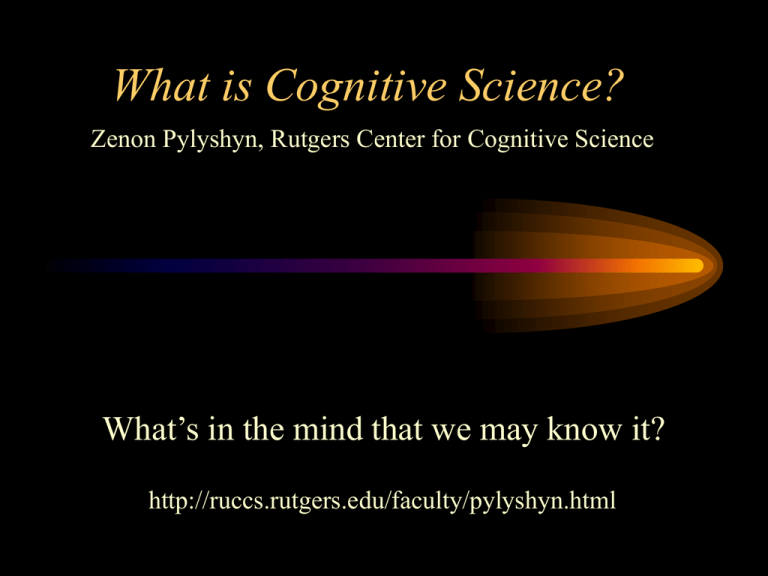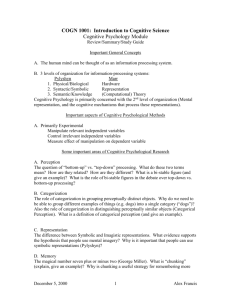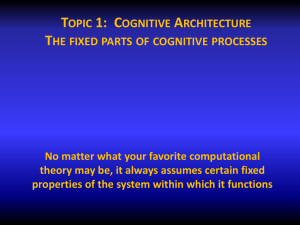PowerPoint slides of Lecture - Center for Cognitive Science
advertisement

What is Cognitive Science? Zenon Pylyshyn, Rutgers Center for Cognitive Science What’s in the mind that we may know it? http://ruccs.rutgers.edu/faculty/pylyshyn.html Cognitive science is a delicate mixture of the obvious and the incredible Granny was almost right: Behavior really is governed by what we know and what we want (together with the mechanisms for representing and for drawing inferences from these) It’s emic, not etic properties that matter Kenneth Pike What determines our behavior is not how the world is, but how we represent it As Chomsky pointed out in his review of Skinner, if we describe behavior in relation to the objective properties of the world, we would have to conclude that behavior is essentially stimulus-independent Every behavioral regularity (other than physical ones like falling) is cognitively penetrable It’s emic states that matter! The central role of representation presents some serious problems for a natural science What representations are about is what matters But how can the fact that a belief is about some particular thing have an observable consequence? • e.g. How can the presence of “holy grail” in a belief determine behavior when the holy grail does not exist? In a natural science if “X causes Y” then X must exist and be causally connected to Y! • It’s even worse than that; even when X exists, it is not X’s physical properties that are relevant! e.g., the North Star & navigation This dilemma is sometimes referred to as Brentano’s problem or the problem of intentionality What determines what we do is what our mental states are about, but aboutness is not a category of natural science. That is why Brentano concluded that psychology was beyond the grasp of natural science. There are other properties that are special to cognitively determined behavior 1. The Semantic determinants of most cognitive behavior. To capture regularities in cognitivelycaused behavior we must use semantic terms – terms referring to what things mean. Samemeaning stimuli are equivalent for many generalizations of cognitive science. 2. The Cognitive Penetrability of most cognitive processes. Almost any regularity can be systematically altered in a quasi-rational way by imparting new information. Is it hopeless to think we can have a natural science of cognition? Along comes The computational theory of mind “the only straw afloat” The major historical milestones • Brentano’s recognition of the problem of intentionality • The formalist movement in the foundations of mathematics: Hilbert, Goedel, Russell & Whitehead, Turing, Church, … • Representational/Computational theory of mind: Newell & Simon, Chomsky, Fodor How to make a purely mechanical system reason about things it does not understand or know about? The discovery of symbolic logic. (1) Married(John, Mary) or Married(John, Susan) and the equation or “statement”, (2) not[Married(John, Susan)]. from these two statements you can conclude, (3) Married(John, Mary) But notice that (3) follows from (1) and (2) regardless of what is in the parts of the equation not occupied by the terms or or not so that you could write down the equations without mentioning marriage or John or Mary or, for that matter, anything having to do with the world. Try replacing these expressions with the meaningless letters P and Q. The inference still holds: (1') P or Q (2') not Q therefore, (3') P Intelligent systems behave the way they do because of what the represent • But in order to function under physical principles, the representations must be encoded in physical properties • How to encode knowledge in physical properties is by first encoding it in symbolic form (Proof Theory tells us how) and then instantiating those symbolic codes physically (computer science tells us how) Cognitive Science and the Tri-Level Hypothesis Intelligent systems are organized at three (or more) distinct levels: 1. The physical or biological level 2. The symbolic or syntactic level 3. The knowledge or semantic level This means that different regularities may require appeal to different levels Calculator example • Why is the calculator’s printing faint and irregular? Why are parts of numbers missing in the LED display? • Why does it take longer to multiply large numbers than small ones, whereas it takes the same length of time to add large numbers as small numbers? • Why does it take longer to calculate trigonometrical functions than sums? • Why is it especially fast at calculating the logarithm of 1? • Why is it that when one of the keys (labeled ) is pressed after a number is entered, the calculator prints what appears to be the square root of that number? Will it always do so? • When the answer to an arithmetic problem is too long to fit in the display window, why are some of the digits left off? Does intentionality (and the trilevel hypothesis) only apply to high-level processes such as reasoning? • Examples from vision. Does intentionality (and the trilevel hypothesis) only apply to high-level processes such as reasoning? • Examples from color vision. “Red light and yellow light mix to produce orange light” This remains true for any way of getting red light and yellow light: e.g. yellow may be light of 580 nanometer wavelength, or it may be a mixture of light of 530 nm and 650 nm wavelengths. So long as one light looks yellow and the other looks red the “law” will hold. Does intentionality (and the trilevel hypothesis) only apply to high-level processes such as reasoning? • Examples from language. John gave the book to Fred because he finished it John gave the book to Fred because he wanted it • The city council refused to give the workers a permit for a demonstration because they feared violence • The city council refused to give the workers a permit for a demonstration because they were communists Methodological aside: On the difference between explanations that appeal to mental architecture and those that appeal to tacit knowledge Suppose we observe some robust behavioral regularity. What does it tell us about the nature of the mind or about its intrinsic properties? An illustrative example: Mystery Code Box What does this behavior pattern tell us about the nature of the box? The Moral: Regularities in behavior may be due to either: 1. The inherent nature of the system (to its structure), or 2. The nature of what the system represents (what it “knows”). Where it matters: Application of the architecture vs knowledge distinction to understanding what goes on when we reason using mental images Examples of behavior regularities attributable to tacit knowledge • Colour mixing, conservation of volume • The effect of image size ? • Scanning mental images ? Color mixing example Conservation of volume example Our studies of mental scanning 2 1.8 1.6 scan image imagine lights show direction Latency (secs) 1.4 1.2 1 0.8 0.6 0.4 0.2 0 1 2 3 4 Relative distance on image (Pylyshyn & Bannon. See Pylyshyn, 1981) There is even reason to doubt that one can imagine scanning continuously (Pylyshyn & Cohen, 1998) If cognition is at a different level of organization than the physical level, how can we ever tell what it is? We are limited only by the imagination of the experimenter, e.g., Relative complexity evidence (RT, error rates…) Intermediate state evidence Eye tracking Stage analysis (additive factors method) Event Related Potentials (EEG) fMRI clinical observations of brain damage Psychophysical methods (SDT) Etc… Example of one methodology: Sternberg memory search paradigm Of course we can’t always be sure we have the right method or instrument If all else fails there is always parsimony and generality…(they worked well in physics and linguistics!)






